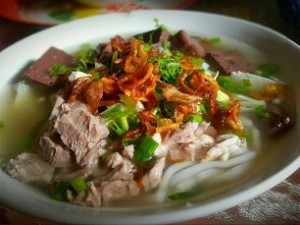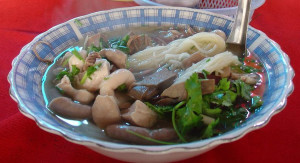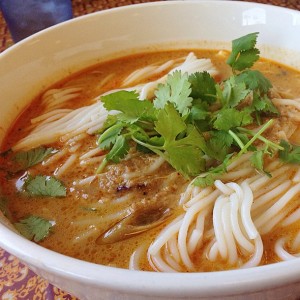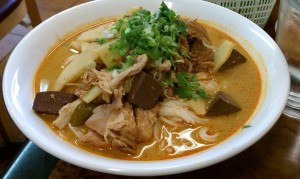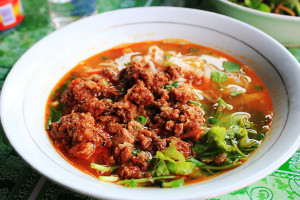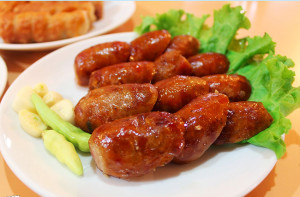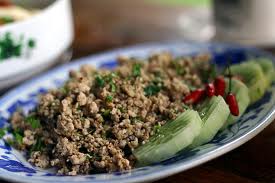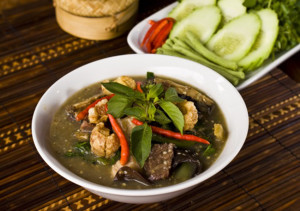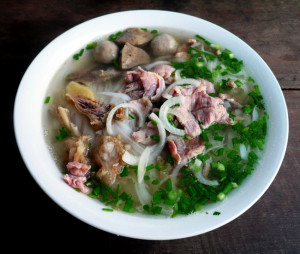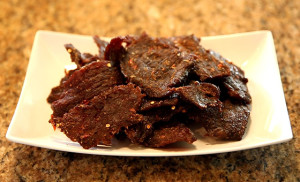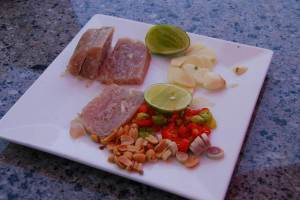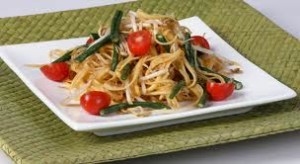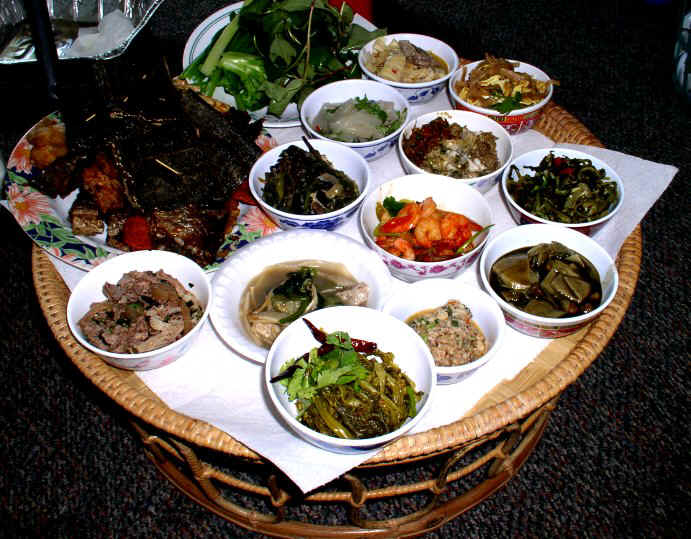
Lao people enjoy fresh vegetables and herbs, for this reason they appear in almost every Lao meals. Meat and fish are usually grilled or steamed as a result, the famous are fresh and the dishes low in fat.
Lao cuisine has many regional variations, due in part to the fresh foods local to each region. You can either enjoy and authentic Lao meal (khao niew or sticky rice is a staple) in many of the restaurants or spend a morning to cook delicious Lao dishes for your lunch.
Lao food is traditionally eaten with sticky rice using fingers. In the countryside, people all eat as family style, sitting on the floor, sharing a few dishes. Lao traditional food is dry, spicy and very delicious based on fish, buffalo meat, pork, poultry and especially herbs. It is always being freshly prepared and not being preserved. Other than sticky rice, which can be eaten either sweet or sour, or fermented and is eaten with fingers, Laotian food is very rich in vegetables and is often browned in coconut oil.
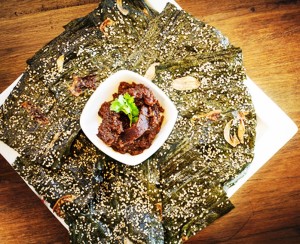 Khaipen (Fried Seaweed) with Jaew Bong
Khaipen (Fried Seaweed) with Jaew Bong
A popular snack, Kaipen is made of freshwater green algae, peppered with sesame seeds and sundried into paper-thin sheets. These raw Kaipen are stored away in rolls. For consumption, the Kaipen sheets are flash-fried in a pan and usually served with jaew bong (chilli paste).
Khao Jee Sandwich (Baguette Sandwich)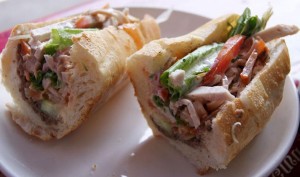
Almost every street corner has a vendor selling this French-Lao fusion. Khao Jee (or baguette) is split in half and filled with lettuce, sliced tomatoes, carrot, onion and optional cheese, moo yor (pork lunchmeat), chopped ham and topped with pâté or chili sauce. Khao Jee sandwich is good with a cup of strong filtered coffee
It’s not really the official breakfast of Vientiane, but it’s so popular that it seems like it. Every morning on the way to work, you’ll pass by many shops, sidewalk stalls, or carts serving up Khao Piak. You’ll see that all of bowl to prepare for the work day ahead.
Khao Piak comes in two main styles of broth. A pork or chicken broth. It’s served with a sticky white noodle that comes in regular or thick size.
Khao Poon (Rice Vermicelli Soup)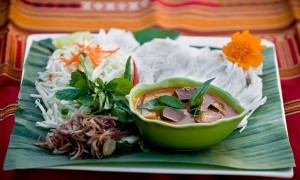
Lao noodle soup, made with long-simmered chili-and-meat-based soup (e.g. fish, pork, chicken). This soup is ladled on the cooked rice vermicelli and a bed of chopped up vegetables such as shallots, spring onion, coriander, mint leaves and string beans. Add fish sauce to taste and enjoy.
This soup uses all the pork innards. Along with the variety of pork parts, it’s also accompanied by a garden variety of vegetables such as thinly sliced bamboo shoots, banana flower, cabbage, and green papaya.
Vientiane has Khao Piak for breakfast. In Pakse, they have Khao Poon Nam Pa for breakfast. In the morning, visit a boat dock where long boats or small barges ferry people and merchants across the Mekong River bringing fresh vegetables to the market every day. There you’re sure to find at least one mobile stand where people are crowded around but not saying too much because they’re busy slurping their noodles.
This is a dark hearty soup with chunks of beef and tendon boiled until tender. Bamboo shoots adds a slightly sour flavor to balance the dark meaty soup. It’s accompanied by thin rice noodles.
Sauce of ground pork and tomato layered on top pork broth. The soup is a fairly simple pork broth with medium wide rice noodles. The highlight is the pork tomato sauce that’s poured on top of the bowl. And it’s accompanied by fresh watercress leaves to balance the heaviness of the pork sauce. The watercress is commonly found Luang Prabang’s highland cool wet climates. Though some watercress can be found in Vientiane, not much is available and the leaves are not as vibrant as the ones found in Luang Prabang.
Also known as ‘sai oua’, Lao sausage makes a pleasant appetizer or snack. Chopped pork meat, seasoned with herbs such as lemongrass, kaffir lime leaves, shallots, cilantro, galangal and flavoured with fish sauce. Good with sticky rice and fresh vegetables.
Laap is a traditional dish made from chopped meat, chicken or duck and is a favorite. The finely chopped meat spices and broth are mixed with uncooked rice grains that have been dry fried and crushed. Laap is eaten with a plate of raw vegetables and sticky rice.
Original to Luang Prabang, this tasty stew comprises mainly vegetables. Beans, eggplant, lemongrass, basil, chilies, woodear mushrooms, cilantro, green onion and locally grown vine called ‘sa kaan’ go into the dish, with optional meat (classically prepared water buffalo meat).
Pho is a noodle soup originally from Vietnam but can be found everywhere in Laos. Featuring thin slices of beef, pork, or chicken, tripe, meatballs and sometimes innards (heart, liver, tongue, etc), with your choice of noodle (e.g. flat or thin rice noodle). Add a handful of greens and a pinch of chili, for the original Lao style.
Sundried beef strips, good with Beer Lao or as a snack. Made from beef flank steak (sometimes water buffalo meat is used), marinated in a mixture of garlic, fish sauce, ginger, sesame seed, sugar, salt and black pepper.
The strips are then left to dry in sunlight, then deep fried until lightly crispy and served with sticky rice or jaew maak len (tomato-based chili dip).
This appetizer is made from chopped, fermented raw pork – sometimes includes rump and skin – and wrapped in green leaves. Fresh chilies are usually inserted into the meat, adding a spicy kick to each bite. You can eat it raw or cooked (e.g. grilled), depending on the menu. The raw version is good with raw cabbage leaves and string beans.
Papaya salad is a type of salad made from sliced raw papaya, garlic, chilli, peanuts, sugar, fermented fish sauce and lime juice.

